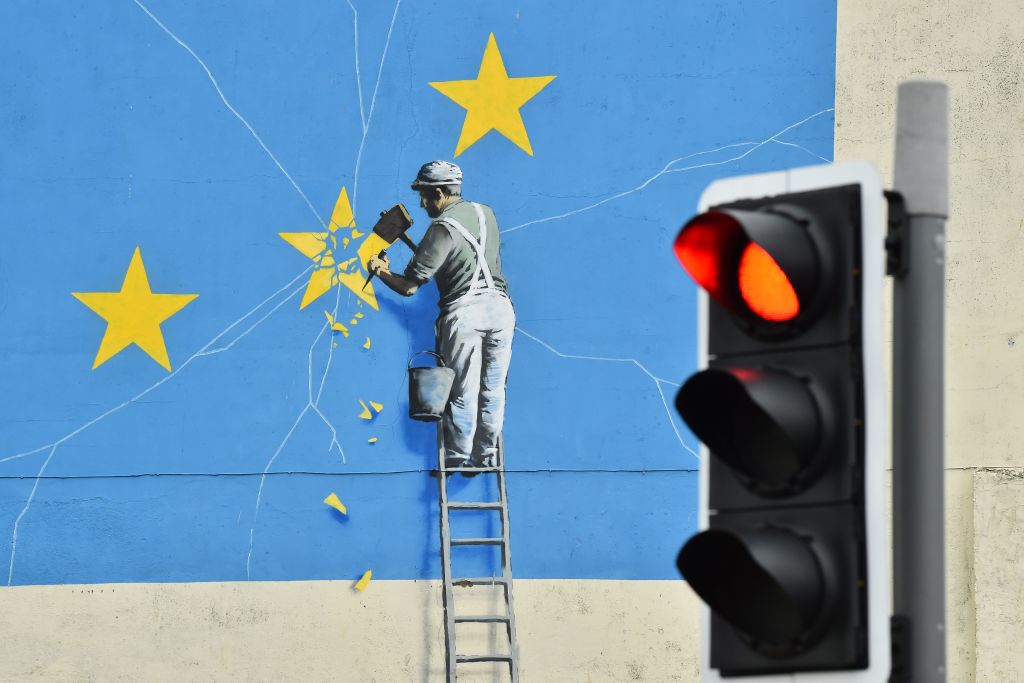
A powerful statement on Brexit by Banksy has disappeared without a trace—or an explanation.
The three-story mural, which depicted a laborer chipping away at one of the yellow stars on a blue European Union flag, appeared in January in Dover, a port city on the English Channel that looks out onto continental Europe. It was installed near the ferry terminal in May 2017 and quickly became a melancholy symbol of what the country stood to lose from Brexit.
Scaffolding was installed on the building last weekend and, on Monday, reports began circulating that the mural had been removed and covered with white paint. So far, there has been no comment or explanation from Banksy or the town of Dover. A representative for Banksy did not respond to an inquiry from artnet News, while a spokesperson for the city said they knew nothing about the mural’s fate.
One official who has been vocal about the work is Dover MP Charlie Elphicke. He said on Twitter that he was “very disappointed” by the disappearance of the “culturally iconic statement on our times.” He noted that the city had asked Historic England to place the piece under protection, but that they refused. “This is the result,” he said. “They should hang their heads in shame.”
Very disappointed by the disappearance of the Dover Banksy. A culturally iconic statement on our times. We asked Historic England to se their powers to protect this work but they refused. This is the result. They should hang their heads in shame. pic.twitter.com/CZC3V7BJzZ
— Charlie Elphicke (@CharlieElphicke) August 26, 2019
Elphicke continued that if the preservation body would agree to protect “the Abbey Road crossing and even a 1960s Bournemouth bus depot described as ‘hideous,’” then “they should have listed an iconic and culturally important piece of art like our Banksy.”
Some are now looking to the owners of the building, members of the Godden family, who own the Godden Gaming Organization and operate a property empire that extends across Folkestone, Thanet, as well as Dover, for an explanation. The now-scaffolded building—a former arcade in Dover—was due to be demolished before Banksy’s viral work showed up there in 2017.
Curiously, the Brexit mural wasn’t the first brush Banksy has had with the family: the Goddens previously lost a High Court battle with the artist over permission to sell one of his murals on a property they owned in Folkestone. When that work, called Art Buff, first appeared, the family told the press that they intended to remove or sell it for £1 million ($1.2 million). (The Goddens added that they would “look to benefit local charities with proceeds from any sale of the piece.”)
It was a weird twist of fate, then, when Banksy chose another Godden family building to create his Brexit mural. And since its unexplained removal yesterday, questions have been swirling on social media. Was the erasure accidental, or a carefully planned gesture by an artist who has a reputation for sparking a media frenzy? Or could the Dover removal be some kind of payback from the Goddens?
Banksy’s Brexit piece had also previously been vandalized with a small tag that said “the clash,” at which point Dover’s district council announced plans to monitor the work with CCTV. But so far, no answers are forthcoming.
“We’re disappointed to see that the Banksy mural appears to have been removed, recognizing that this unique artwork had become a popular tourist attraction in the town,” a Dover district council spokesman told artnet News. “The property, which is in a state of considerable disrepair, is privately owned, and the council was not involved in the current activity, and was not made aware of any plans for it to take place.”